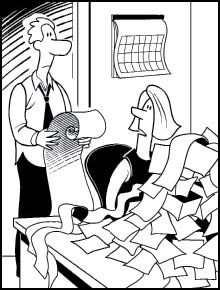Part II
Forming a Plan
Glenn Lumsden

‘Every year we end up in the same situation . . . one week to get our books to the accountant. What we need is an accountant lazier than us.’
In this part . . .
If you’re working as a bookkeeper for a business where all the systems are up and running already, then you probably don’t need to read this part of Bookkeeping For Dummies right now. However, if you’re just getting started with a new business, or you’re going into a business where you suspect that the systems are a bit outdated or inefficient, then these next few chapters are written just for you.
In Chapter 4, I provide a general rundown of a bookkeeper’s timetable, in the hope that you can get everything submitted on time and avoid those pesky government fines. In Chapter 5, I explore the decision about whether you need accounting software, and if so, how to choose a system that’s going to sing, dance and cook your dinner (or, at least, help you determine if someone is cooking the books).
I get terribly earnest in Chapter 6, where I talk about fraud, and how not to be a victim of it. This chapter probably won’t mean much to small owner-operators with no employees, but if you’re a bookkeeper working for a larger business, or you’re a business owner who delegates money stuff to other employees, then this chapter could truly save your bacon.
In Chapter 7, I take a look at GST. I find ...

